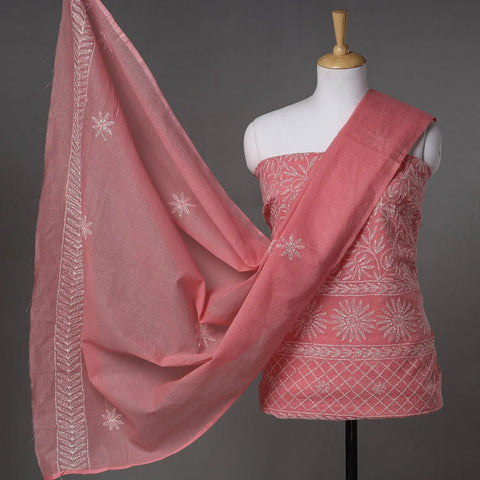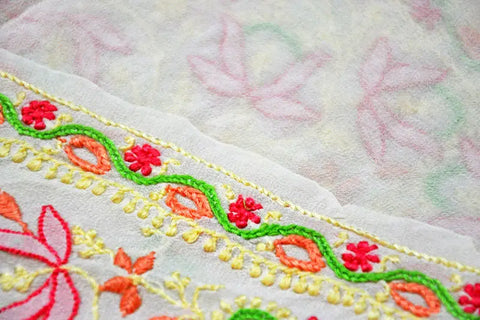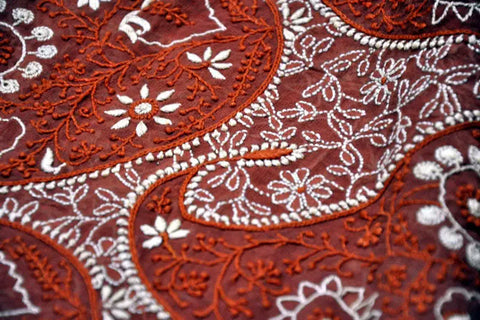Chikankari embroidery, one of its unique forms of hand embroidery from Lucknow, requires a variety of stitching techniques that are learned over the course of many years of rigorous labour. Chikankari embroidery stitches add a unique charm to the embroidery, however, chikan embroidery demands focus and discipline throughout execution.
Did you know, that 32 different Chikankari embroidery stitches are used in Lucknowi Chikankari embroidery? The five fundamental Chikankari stitches that are often used are Phanda, Jaali, Tepchi, Murri, and Bakhia. In this blog, let us share with you more about these traditional Indian embroidery stitches and how handcrafted Chikankari designs became popular in India.
The Royal History of Chikankari Embroidery
The history of Chikankari embroidery can be dated back to the Mughal era in India. This traditional embroidery style originated and flourished under the Mughals in the 16th and 17th centuries. It is believed Mughal emperor Jahangir’s wife Mehrunisa, also known as Noor Jahan brought this intricate art to India from Persia.
Noor Jahan was captivated by the intricate beauty of white-on-white embroidery. Under her influence, handcrafted Chikankari designs reached new heights with many elegant stitches reserved only for the royals.
In the history of Chikankari embroidery, it is often noted that designs and motifs were inspired by nature. Artisans used floral and foliage designs that were very common which later inspired different types of Chikankari embroidery stitches.
Today Lucknow, Uttar Pradesh in North India is known as the Chikankari capital. Chikankari craft is known for its delicate and intricate handwork, which involves creating patterns on lightweight fabrics like muslin, cotton, chiffon, and silk.
Different Types of Chikankari Embroidery
Lucknow Chikankari Embroidery is a labour-intensive craft that requires great skill and precision. It is typically done by hand with a needle and thread. The Lucknow chikan embroidery process involves creating the outline of the design using the backstitch and then filling it in with various stitches to give it texture and depth.
The different types of Chikankari embroidery that are often used are Phanda, Jaali, Tepchi, Murri, and Bakhia.
Phanda
Phanda is a small, circular-shaped stitch commonly used in Chikankari work. It is created by making tiny, evenly spaced knots on the fabric, forming raised dots. Phanda stitches are often used to fill spaces within larger motifs.
 image credit- D'source
image credit- D'sourceJaali
Jaali, also known as network, involves creating a delicate lattice or net-like pattern. The fabric is carefully cut, and threads are drawn out to form a grid-like structure. The threads are then embroidered with fine stitches to create intricate designs.
 image credit- D'source
image credit- D'sourceTepchi Chikankari
Tepchi is a running stitch and one of the basic stitches in Chikankari work. It is created by passing the needle and thread through the fabric in a straight line. Tepchi stitches are used for outlining motifs, creating borders, or filling in areas with parallel lines.
Murri
Murri work adds texture and dimension to Chikankari embroidery. It involves creating tiny knots or beads with a needle and thread. Murri stitches are used to form raised dots or motifs on the fabric, adding a decorative element to the design.
 image credit- D'source
image credit- D'source
Bakhia
Bakhia stitch is a flat stitch used in Chikankari embroidery. It is created by making diagonal or slanted stitches on the fabric, usually in a crisscross pattern. Bakhia stitch is used to fill spaces within larger designs or to create geometric patterns.

Baccha
Just like others, if you are also fascinated by chikankari kurti designs, then you might be amazed to know that the stitching style that creates the fine flower motifs using thread work is known as baccha chikan embroidery stitch. Identifying this stitch is pretty simple. You can be assured that most of the time the silk and cotton chikankari kurti with complex designs come alive using this stitching.
Keel
When you admire diagonal stitches of chikankari work that appear similar to fish scales on cotton, chiffon or muslin sharara, sarees, salwar kameez or lehenga cholis sets, you are admiring keel kangan chikan embroidery stitch.
Ghaas Patti
Chikankari motifs can be similar to the eyes of a novice but distinctive to the experts. The V-shaped stitches that create the grass-like Lucknowi embroidery designs are known as the ghaspatti stitch. You can notice this Lucknowi embroidery on various chikankari work products.
Shadow Work
Have you seen how some chikankari embroidery stitches look shadowy yet phenomenal? These are the results of bakhia stitching. The floats of the embroidery create a shadow-like appearance on the clothes’s front that you cannot help but admire in awe.
Rahet
When you create a design on a chikankari fabric using six threads together, the rahet chikankari stitching style is in play. More often than not, the complex rahet work breathes life into the awe-inspiring designs on embroidered clothes.
Parsi
Who does not admire the smooth-flowing, pictorial chikankari kurti designs? These designs are the results of Parsi chikankari embroidery work. Apart from kurtis, you can notice this work on other clothing items such as salwar kameez, and sarees.
Booti
Not many people are aware of the booti chikankari work but it’s a sight to see. The classy, elegant and minimal booti stitches are soothing to the eyes.
How Chikankari Stitches Define Royal Elegance
Every stitch of Lucknowi Chikankari embroidery has a story woven into them often embodying a royal elegance. Once upon a time, during the Mughal period, handcrafted Chikankari designs were reserved only for royalty.
Even today these traditional Indian embroidery stitches are known for their fine delicate touches inspired by the refined tastes of royalty. Often brides are seen sporting chikankari sarees and lehengas on their big day.
Lucknowi Chikankari embroidery mirrors the grandeur and opulence of the royal courts. Today chikankari is popular among Indian women and men from all corners. While we have often seen Bollywood actresses sporting Chikankari kurtis and Chikankari stitched suits, you can also find young college-going girls in Chikankari Pants & Palazzo and Chikankari Stoles.
These traditional Indian embroidery stitches narrate a tale of royal heritage and timeless elegance.
Conclusion
Chikankari embroidery is used in various ways to create intricate and beautiful designs. Skilled artisans employ their expertise to create a wide range of patterns and motifs using these stitches.
iTokri brings authentic Lucknowi Chikankari embroidery directly from the artisns to your doorsteps. From Lucknowi chikankari dupattas to Chikankari dress materials you can find it all at your favourite handicraft store online, iTokri.
FAQs on Chikankari Embroidery
What is the Chikankari method of embroidery?
The word Chikankari originates from Chakin, a word in Persian meaning embroidery. The art form has a rich history and is believed to have been introduced in Lucknow by the Mughals in the 18th century.
What are the types of embroidery in Lucknow?
The different types of embroidery in Lucknow are Zardozi, Kamdani, Aari, Sozni, and Chikankari Embroidery.
Which embroidery stitches produce an embossed effect in Chikankari?
In Chikankari embroidery, there are certain stitches that are used to create an embossed or raised effect on the fabric. These stitches include Murri, Bakhiya, and Phanda.
How many Chikankari embroidery stitches are there?
There are 32 different stitches of Chikankari embroidery. Though all but one of them share characteristics with different types of needlework, one can broadly divide them into six major groupings.
Which are the popular Chikankari embroidery stitches?
In Chikankari embroidery, several stitches are popular and commonly used to create intricate and beautiful designs. However, some of the popular Chikankari embroidery stitches are Phanda, Jaali, Tepchi, Murri, and Bakhia.
What stitches are used in Chikankari?
There are over 32 different types of chikankari embroidery stitches that have been used for centuries. Some of the popular stitches in chikankari are Phanda, Jaali, Tepchi, Murri, and Bakhia. You can also find other stitches like Parsi, Booti, Ghas patti and more.
Which thread is used in Chikankari embroidery?
Chikankari embroidery is generally done with cotton thread, but depending on the material and look zari and silk threads are also used.
 Verified Purchase
Verified Purchase









































Leave a comment (all fields required)